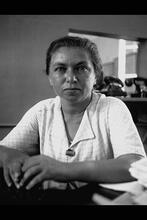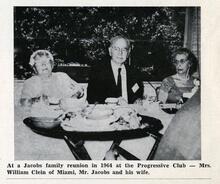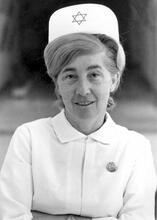Malka Kolodny
Malka Fisz Kolodny served as one of the first teachers in pre-State Palestine. Raised in Poland and educated in France, she immigrated to Palestine with her husband in 1936. When she was widowed in 1942, she began teaching at the Women Worker’s Farm and other settlements near Haifa to support her two daughters. Her pupils were a mix of Syrian refugees, Holocaust survivors, and Youth Aliyah immigrants, and she taught subjects ranging from basic literacy to chemistry and biology. After the founding of the State of Israel, she earned one of the first teaching certificates issued and continued to teach science at high schools throughout Haifa, often translating textbooks from Russian. After her retirement, she translated memoirs of Holocaust survivors and the Labor Brigade.
Early Life
Malka Kolodny (née Fisz), one of the earliest educators in pre-State Palestine, was born in Horodziec in the Volhynia district of Poland, on June 17, 1910, the youngest of eight children of an Orthodox Jewish family. Her father owned a small flour mill—one of the first such steam-powered facilities in the region. Her abilities and thirst for knowledge were obvious even in elementary school (shkola), where she helped the children of the village priest with their studies. Living so close to the border, she saw the region frequently change hands among the Ukrainians, White Russians, and Red Russians in the years following the 1917 revolution. As a young girl, she was often witness to acts of cruelty against the Jewish population, which reinforced her longing for independence and her dreams of the Land of Israel. With the consolidation of Polish rule in the region following World War I, she studied at the Clara Erlich Polish-Jewish gimnazjum in the district capital of Kovel. After earning her Polish matriculation certificate she traveled to France to continue her studies with the support of her brother Lieb Fisz, one of the major merchants in Kovel and a founder of the Tarbut gimnazjum there. In 1933 she received a degree in chemical engineering from the University of Caën.
Immigration and Early Teaching
After marrying Moshe Kolodny in 1936, she immigrated with him to pre-State Palestine. The couple lived in Haifa, where their two daughters were born. When Kolodny was widowed in 1942, she became involved in teaching in order to support her daughters. Initially, she taught at the Meshek ha-Po’alot (Women Workers’ Farm) in the Borochov quarter, located alongside the home of Avraham Aldema, who served as cultural coordinator for the neighborhood. Like those in Petah Tikvah, Nahalat Yehudah, and Afula, this farm, run by Leah Miron (1888–1967, widow of Berl Katznelson), was established to train women to work the land. In 1946, young girls from Syria who had arrived without their parents as “illegal” immigrants were brought to the Meshek ha-Po’alot in Borochov. Kolodny taught them how to read and write, serving as their guide and teacher and helping them integrate into the local lifestyle. One year later, orphaned boys who had survived the concentration camps in Poland and Transnistria also arrived in Palestine. It was at this time that she learned that her entire family—parents, brothers, nephews, and nieces—had perished in the Holocaust, some of them in a mass slaughter in the Vladimirets forest and others at the synagogue in Kovel. Kolodny invested much love, caring, and concern in these young boys, not only serving as their teacher but coping with their outbursts and despair and becoming involved in their rehabilitation and vocational training. She also encouraged cultural activities and excursions to A voluntary collective community, mainly agricultural, in which there is no private wealth and which is responsible for all the needs of its members and their families.kibbutzim and brought together “the Syrian girls” and Youth Lit. "ascent." A "calling up" to the Torah during its reading in the synagogue.Aliyah immigrants with native-born Israelis. Both groups of newcomers maintained contact with her for decades, citing her sincere love for them and her special character, which enabled them to adjust to their new lives and to develop positive aspects of their personality.
Kolodny’s next stop was the Gordonia-Hulda A voluntary collective community, mainly agricultural, in which there is no private wealth and which is responsible for all the needs of its members and their families.kevuzah (precursor of the A voluntary collective community, mainly agricultural, in which there is no private wealth and which is responsible for all the needs of its members and their families.kibbutz), where she taught from 1947 to 1950. Here as well, she stood out for her patience, love, and ability to set problematic young people on the right track, in particular the students from Youth Aliyah. During the Israel War of Independence, Hulda served as a military base from which convoys set out for Jerusalem; it was also the starting point of the Burma Road (a by-pass road constructed to circumvent the blockade of Jerusalem). Due to shelling, the women and children were transferred to the Trumpeldor School in Tel Aviv along with Kolodny; even while in the bomb shelter, she continued to convey the importance of study and a love of reading, and to teach handicrafts to the adults and children confined with her.
Post-State Career
When the Ministry of Education was established with the founding of the state, Kolodny received—after further pedagogical training—one of the first teaching certificates in the country: certificate no. 22. She taught chemistry and biology, relying partly on textbooks that she herself had translated from Russian.
In 1950 Kolodny left the kibbutz after deciding that her two daughters needed to earn a matriculation certificate, which could not be obtained at the kibbutz schools at the time. She moved near Kiryat Tiv’on, where she was one of the first teachers at the Greenberg High School. She later taught at several high schools in Haifa, among them the Alliance, Shabtai Levi, and Leo Baeck schools, and the Gordon Teachers College. Kolodny taught science and chemistry at Haifa high schools for decades.
Other Work and Legacy
After Kolodny stopped teaching, she founded (with the help of the Kiryat Tiv’on Municipal Council) the Fisz Brothers Community Center in memory of her brothers and other family members killed in the Holocaust. It now serves as an educational and cultural center for children of the surrounding area and the name of the street on which it is situated has also been changed to Fisz Brothers Street.
Kolodny translated works from Russian, Yiddish, and French into Hebrew, including Rasputin and the Jews: Memoirs of the Personal Secretary of Rasputin by Aharon Simanovitch (1995), from the Russian; Gray-Haired Children by Gilbert Chesbron (undated), from the French; and the memoirs of Holocaust survivors, and of members of the Gedud ha-Avodah (Labor Brigade) who returned to Russia, from unpublished manuscripts in Yiddish.
Kolodny educated generations of students who maintained ties with her for years, among them internationally renowned researchers in the field of chemistry. Her daughters are Dr. Rachel Sebba (b. 1942), a senior lecturer in architecture at the Technion in Haifa, and Ruth Bachi-Kolodny (b. 1939), an author and radio broadcaster with Kol Israel.
Malka Kolodny passed away in 2002.
Kressel, Getzel. The Borochov Quarter: History of the First Workers’ Neighborhood (Hebrew). Givatayim: 1961.
Le’oni (Tsuperfein), Eliezer, ed. Kovel Memorial Book (Hebrew). Tel Aviv: Irgun yots’e Kovel be-Yisra’el, 1957.
Zhori, Shoshana, ed. The Educational Battlefront 1948–1952 (Hebrew). Tel Aviv: 1991.
Archives, Kibbutz Huldah.












